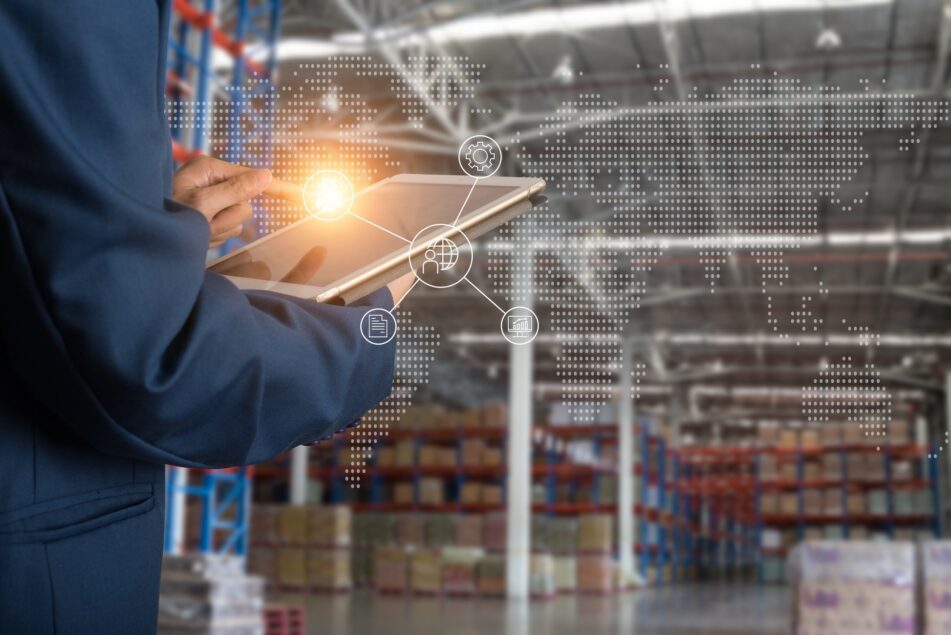[ad_1]
Some technologies are becoming absolutely essential in warehouse operations, boosting productivity, reducing errors and improving visibility throughout your operation. Here are five of them.
1 RFID
Radio frequency identification (RFID) has become an indispensable technology for warehouses and DCs, helping tackle big challenges like labor shortages and the need for faster, more efficient operations.
Because it uses radio waves to wirelessly identify and track objects, warehouses can get more done with a leaner workforce, freeing up personnel from manual tasks and letting them focus on higher-value activities. Plus, when paired with cutting-edge tech like machine learning (ML) and AI, RFID unlocks a new dimension of data insights and intelligence.
RFID slashes receiving time from hours to minutes, while reducing errors, by speeding up receiving, providing real-time inventory tracking, enabling smarter order picking, and providing error-free shipping. Instead of workers scanning boxes manually, RFID portals can automatically read all tags as pallets pass through. Fixed readers in different zones, and handheld readers can create an up-to-the-minute map of inventory locations throughout the warehouse, eliminating lost items and the need for manual cycle counts. This means quicker picking times and fewer delays. And when RFID is integrated with supplier data, DCs can automatically check if what was shipped matches the advance ship notice (ASN). If there’s a mismatch, the system flags it immediately for investigation.
Workers equipped with mobile RFID readers can quickly locate the right items and confirm they’re picked correctly. Then, before shipments leave the dock, RFID readers can double-check that everything is packed correctly for each order. For distribution centers serving multiple retail locations, RFID verification prevents costly mistakes like sending the wrong products to the wrong store.
Layering analytics software on top of the RFID infrastructure transforms raw data into actionable insights that warehouse managers can use to make informed decisions about staffing, layout changes, or process improvements. And when RFID is integrated with systems like WMS or ERP, managers can get a full-picture view of their supply chain.
Lastly, the declining cost of RFID tags and labels over the past decade has been a significant catalyst for broader adoption in warehousing.
2 Machine Vision
Machine vision is relatively new to warehouses and DCs, making order fulfillment more quick, predictable, adaptable and on-demand. It can check the quality of goods at the receiving dock, also making sure the goods are compliant with regulations, and carry accurate shipping labels. Because of rapid workforce turnover, warehouse workers might not know what to check regarding inbound goods. Machine vision makes primary checks more reliable and empowers a new person to operate with almost the same expertise as someone who’s been working in the warehouse for years.
Machine vision cameras reduce the need for manual inventory counts and minimize errors. They can look at and optimize available storage space, identify and track the location of pallets and boxes, and ensure accurate placement and retrieval of inventory. Machine vision can also measure the dimensions and conditions of incoming loads in order to accurately plan for storing, picking and dispatching.
Even better, machine vision can do two things at once, such as doing primary checks on incoming loads while gathering security validation to make sure each truck that comes into the loading yard is authorized to be there.
3 Artificial Intelligence
One of the most exciting advantages of AI is that it is able to digest and make sense of the vast data lakes that are being created as goods move through the supply chain and into the warehouse. In many ways, AI is the automation tool that allows all other automated technologies to do their jobs better. For example, if you have robots helping pick orders, AI can identify via analytical software that there’s a slowdown in pick rates during a shift because of congestion in the pick area for a particular product. Having been alerted to this, the warehouse manager can investigate and spread out the picking to other areas that are under-utilized. AI creates a searchable database of all package images and dimensions from across your entire supply chain. It can even learn customer ordering patterns and recommend that items commonly picked together are stored close to each other in the warehouse, improving productivity and order processing speed.
4 Automated Palletizing/Depalletizing Technology
Semi-automated and robotic palletizing and depalletizing equipment can quickly and precisely build or unload pallets, eliminating the need for manual handling. In addition to helping overcome the ongoing labor shortages in warehouse operations, automated palletizers/depalletizers can reduce workplace injuries and fatigue, improve employee safety, and handle building/unloading tasks faster and more consistently.
Palletizing robots are versatile and can handle a variety of layer patterns, product packaging and container demands to build stable pallet loads quickly and efficiently for wholesale distribution or direct-to-retail replenishment. A depalletizing robot can sort and place pallets according to warehouse requirements, even if the items vary in shape or size. For example, a robot can break down a mixed-load pallet of shoes and place all the size 11s in one place, all the size 9s in another, and so on. Then it can deliver them to a conveyor, or an e-commerce staging site, or to a shelving system for later picking. Robotic palletizers/depalletizers that integrate with conveyance and sortation systems can create a fully-automated material handling operation that reduces the number of workers needed and improves efficiency by 50% or more.
5 Wearable Robotics
When a worker injures themselves in the warehouse, it can cost more than $50,000 per incident, and it’s not unusual for a warehouse to report dozens of injuries in a year. Less drastic, but also likely to hamper the efficiency of warehouse operations, is the natural tendency of the human body to tire halfway through a shift. Wearable robotics, or powered exosuits, preserve the safety and wellbeing of workers. They not only offload the weight of everything physically lifted by 40%, they also share data on individual workers to be analyzed by AI, such as whether their rate of work has decreased, indicating fatigue, or whether they need training, and even if they are lifting, bending or twisting in a way that’s likely to cause injury.
A Partnership for Warehouse Automation
Peak Technologies and Honeywell International Inc. work in partnership to make warehouse operations more efficient and worker-friendly.
About Peak Technologies
Peak Technologies is a leading global solutions provider focused on empowering productivity in manufacturing, warehousing, T&L, retail and field service organizations. By providing advanced technologies and supply chain automation, Peak provides digitally-connected mobile workforce solutions, worldwide managed services, and evolving smart technologies including RFID, machine vision, robotics, process analytics, AI and more.
About Honeywell International Inc.
Honeywell, a Fortune 500 company, primarily operates in four areas of business: aerospace, building automation, industrial automation, and energy and sustainability solutions. Honeywell’s warehouse and logistics automation solutions eliminate warehouse bottlenecks with technology for every major warehouse workflow.
Honeywell Intelligrated offers one of the broadest portfolios of advanced automation hardware and software in the industry — from conventional solutions to the latest warehouse robotics, to hybrid solutions that combine the strengths of multiple technologies. The company also offers world-class service and support.
Resource Links: https://www.peaktech.com/industries/warehouse-distribution/, https://www.honeywell.com/us/en/industries/warehouse-logistics
[ad_2]
Source link



